Physics Laws of Motion
Get insights from 189 questions on Physics Laws of Motion, answered by students, alumni, and experts. You may also ask and answer any question you like about Physics Laws of Motion
Follow Ask QuestionQuestions
Discussions
Active Users
Followers
New answer posted
3 months agoContributor-Level 10
The period T is the time taken to complete one full revolution (2? radians). In uniform circular motion, it relates to angular velocity by? =2? /T and to tangential speed by v=? r=2? r/T .
New answer posted
3 months agoContributor-Level 10
The principle of circular motion follows Newtonian mechanics. It can be stated that an object will move in a circle only when there is a centripetal force that continuously acts perpendicular to its tangential velocity. That changes the direction but not its speed. The inward acceleration a_c = v squared/r obeys Newton's laws and ensures circular path motion.
New answer posted
3 months agoContributor-Level 10
Circular motion has the following characteristics.
- Fixed radius with the same and constant distance from the centre
- Constant speed, when the motion is uniform
- A changing velocity vector with continuous direction of change
- Centripetal acceleration that is directed radially inwards, while the force that causes it is the centripetal force that maintains the curved path
New answer posted
3 months agoContributor-Level 10
Yes. Friction is a contact force that works against the relative motion between two surfaces. It can be static, which prevents motion. It can also be kinetic, which resists motion that's already happening.
New answer posted
3 months agoContributor-Level 10
The four key contact forces that you will read in Class 11 Physics are normal force, friction, tension, and spring force. Each of these forces needs physical contact and follows Newton's Third Law. They come into play during motion, compression, stretching, or when objects rest on surfaces. These contact forces help in drawing the free-body diagrams (FBDs) and solving problems related to the laws of motion.
New answer posted
3 months agoContributor-Level 10
An object usually experiences four primary forces. First is the gravitational force (or weight) pulling it downward. Surfaces exert normal force, while frictional force works against motion. Then the applied or tension force starts any movement. These forces can either balance each other out or be unbalanced.
Taking an Exam? Selecting a College?
Get authentic answers from experts, students and alumni that you won't find anywhere else
Sign Up on ShikshaOn Shiksha, get access to
- 65k Colleges
- 1.2k Exams
- 679k Reviews
- 1800k Answers



